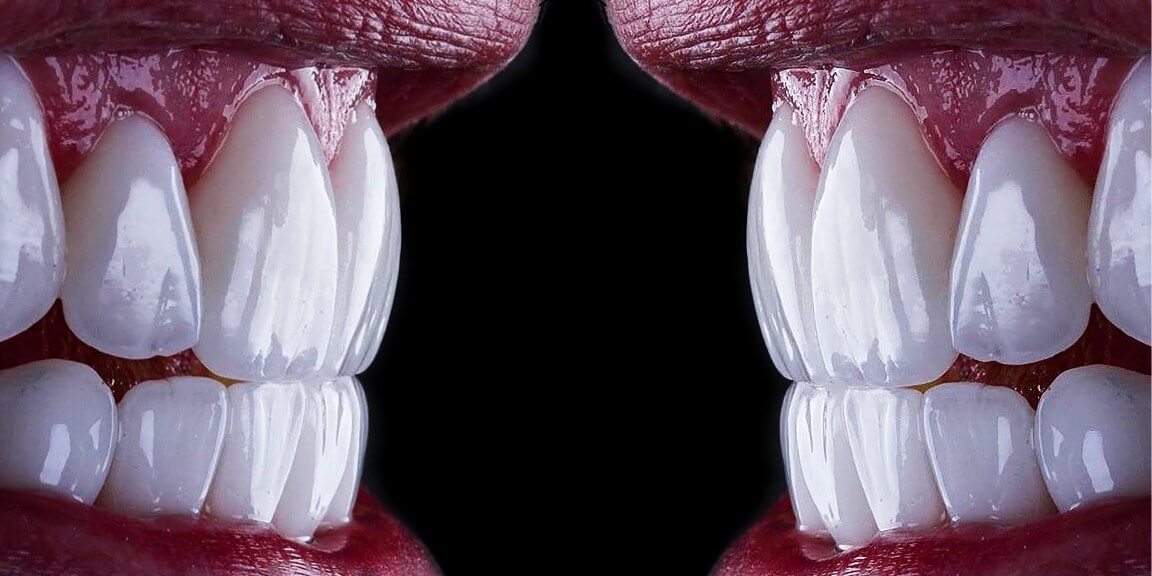Let’s face it. How your teeth look matters to you. It’s not about anyone else. Your smile should make you feel comfortable and confident. But some of us just weren’t born to have immaculate chompers. Genetics happens. Life takes its toll. And now you’re faced with a pivotal decision. Therefore, in this blog we will cover all you need to know about Porcelain Veneers vs Composite Veneers vs Lumineers
Porcelain veneers vs Lumineers? What about composite?
You’ll find what you’re looking for here. We’re going to walk through everything you need to know. Now, we want you to know you’re in for a 5 to 10-minute read. But like a great workout session, this will be so worth it.
What Are My Options?
Your Veneers SnapShot
Veneers are semi-permanent, wafer-thin tooth-colored shells bonded to your teeth. They’re personalized and customized specifically for you.
They’re also called dental porcelain laminates. Don’t let the name deter you. Laminate has come a long way over the past 10 to 20 years.
Veneers can aesthetically change the color, shape, and arrangement of your teeth, giving you the smile you’ve always dreamed of. Your dental health professional can veneer one or multiple teeth while matching the others.
Porcelain Vs Composite Veneers
Veneers come in two options, and here are the main differences between them.
- Porcelain veneers.
- Your dental health professional removes 1/2 mm of enamel before affixing the veneer semi-permanently to each tooth. Many like porcelain because it’s reflective (similar to natural teeth), more stain-resistant, and longer-lasting (10-15 years rather than 4-8 for composite). For these reasons, they’re also more expensive but not necessarily more cost-effective. We call them semi-permanent because you may have to replace them at some point, but the decision to get porcelain veneers is undoubtedly a permanent decision.
- Composite veneers.
- These resin veneers can attach to the front of the tooth without damaging the tooth. Many prefer composite because it does not require the removal of enamel, which is critical for dental health. This rock-hard, calcium-based natural tooth protector doesn’t grow back. If you change your mind, a dentist can remove composites and return your teeth to the “before veneers” picture.
| “Dental veneers help improve the appearance of a person’s teeth. They may be beneficial for people who want a long-term solution to persistent cosmetic concerns — particularly those that do not respond to other dental treatments, such as teeth whitening, braces, or retainers.” — Medical News Today |
A Quick Look at Lumineers®
Lumineers is a brand name for a special type of veneer. It’s ultra-thin porcelain that slides comfortably over your teeth to look like natural teeth — no alterations required.
So you’re not locked in. A dentist can remove them, and you’re no worse for wear. They give you a radiant smile without damaging the tooth.
Who’s a Good Candidate for Porcelain Vs. Composite Vs. Lumineers?
If you want to improve the vibrancy of your smile, but some teeth aren’t responding to whitening, you may be a good candidate for one of these forms of Cosmetic Dentistry.
Regardless, you need healthy teeth and gums. After all, in all cases, the dental solution covers your natural teeth, so those teeth must be sturdy.
A generally well-aligned smile is also important. Veneers can correct some aesthetics. But they can’t make teeth seem perfectly aligned. Veneers can, however, handle a little more misalignment than Lumineers.
You can, as an example, look at Tom Cruise.
While he has not discussed it openly, many dental professionals strongly suspect he has porcelain veneers. And as many have pointed out, one of his front teeth is off-center. Veneers will not perfectly correct crooked teeth, but those of us who saw Risky Business and later Mission Impossible, know they can do a lot.
Each of these options can help with minor imperfections. This message will not self-destruct.
Those who grind and clench their teeth may not be good candidates. While temporary bruxism can occur after a dental procedure, for most who have it, it’s chronic. The human jaw can apply 70lb of pressure per square inch, so yeah, not great for teeth, veneers, or Lumineers.
Your non-covered teeth need to be at your preferred whiteness. Your dental health professional will match the veneer or Lumineer to your other teeth, so if your other teeth are significantly-stained, you’ll want to address that first.
If you whiten after your veneer or Lumineer is designed and not before, it will stick out like a sore thumb.
Porcelain Veneers Vs Lumineers Vs Composites
Let’s break it down.
Porcelain veneers are stain-resistant, long-lasting, and cost more. They require some prep work, which involves removing enamel from the tooth, so the thin veneer doesn’t stick out from your other teeth.
Composite veneers don’t require enamel removal, but they look slightly less like your real teeth. And you’ll have to replace them more often.
In contrast, Lumineers may be the best of both worlds. They are porcelain, so they mostly mimic natural teeth. But like composite veneers, a dentist can remove them without tooth damage.
In general, both types of veneers can handle a little more misalignment than Lumineers.
The Procedure: Your Journey Toward a Radiant Smile
Whether you choose veneers or Lumineers, both options are a great way to improve your smile. It’s no wonder they’re so hot in image-driven Hollywood. You could join celebrities like:
- Tom Cruise
- Meghan Markle
- Hillary Duff
- Emma Roberts
- Cardi B
- Miley Cyrus
- Snooki
Here’s what to expect:
- Diagnosis & Assessment. Your dental health professional inspects your teeth and gum health and addresses any issues. They discuss which is your best option based on your unique mouth profile.
- Smile Design Process. Actively work with a dental professional to design the color, length, shape, and look.
After this, the process diverges depending on your choice, so let’s take a look.
For Porcelain Veneers
- Apply local anesthetic. Your dentists will use local anesthetic to ease the pain while proceeding with the treatment.
- Prepare the tooth. The specialist uses specialized equipment to shape the tooth and then shave a thin layer from the surface.
- Make an impression. This impression may be sent to an outside lab to make the veneer, or it may be done in-house. Note: If an outside lab is used, you may get temporary veneers
- Fabricate, bond, and adjust.
- Take care of your veneers. You’ll get instructions on proper care, which includes regular dental exams and cleanings. Do not bite or chew on hard objects. Brush and floss regularly.
For Composites Veneers
- Apply a liquid resin.
- Shape the resin.
- Harden the resin using a special light.
- Apply additional resin layers to achieve the right look.
- Polish
- Take care of your veneers, following the above guidelines.
For Lumineers:
- Get an impression
- Create and bond.
- Polish and finish.
- Take care of your Lumineers, following the above guidelines.
Pros & Cons
Porcelain Veneers Pros & Cons
Pros:
- Natural look, but brighter and whiter while matching other teeth
- Stain-resistant
- Highly-customizable
- Can “repair” the appearance of broken teeth, lost enamel, or moderate misalignment
- Durable, 10-15 years
Cons:
- Higher initial cost
- Not reversible. You must replace them every 10 years or so. You can’t just take them off.
- Could damage nerve
- May have to wear temporaries for 4-6 weeks
Composite Pros & Cons
Pros:
- Can improve your smile
- Highly-customizable
- Can “repair” the appearance of broken teeth or moderate misalignment
- Doesn’t cause tooth damage
- Can be removed and not replaced
Cons:
- Don’t last as long,
- Not as durable
- More porous, prone to stains
- Doesn’t last as long, 4-8 years
Lumineers Pros & Cons
Pros:
- Looks more like real teeth
- Doesn’t cause tooth or nerve damage
- Less expensive than veneers
- Durable, can last up to 20 years
- No temporaries
- Reversible
Cons:
- On very close inspection, they may look slightly chunkier because they go on an unaltered tooth
- Must be thicker if covering a darker tooth or tooth shows through
- For Lumineers teeth need to be fairly straight
How Much Do Lumineers Vs Veneers Cost?
According to the American Dental Association, veneers can range from $925 to 2500 per tooth. We already know that composites are the cheaper ones.
According to Healthline, Lumineers cost $800 to $2000 per tooth.
Insurance does not pay for cosmetic dentistry, but cosmetic dentistry offices offer no-interest financing that allow you to pay over 3 or more months.
Alternatively, you could use a credit card, but then you’d pay interest — not ideal. To learn more about veneer’s cost visit our full article covering the cost of veneers.
Frequently Asked Questions
Do veneers damage teeth?
If you get porcelain veneers, the answer is yes. Composite veneers and Lumineers do not damage teeth.
Are veneers permanent?
Porcelain veneers are a permanent decision. While the veneer itself doesn’t last forever, you will need to replace them if they break or wear out. Composite veneers and Lumineers can be removed by a dentist and replaced, or not –your choice.
Porcelain veneers last around 10-15 years, although 20-30 isn’t unheard of with proper care. Composite resin veneers last 4-6 years. Lumineers can last up to 20 years.
How much do veneers and Lumineers cost?
Veneers cost $925 to 2500 per tooth. Lumineers cost 800-$2500 per tooth.
Which Is the Best Option for You?
Some options will work better for some people’s specific dental needs, so you should certainly speak with a professional. If we had to pick one as the all-around favorite, we always opt for the best results with the least invasiveness. For most, that would be Lumineers.
To learn more about these and other cosmetic dentistry options to achieve your Hollywood smile, contact us.


